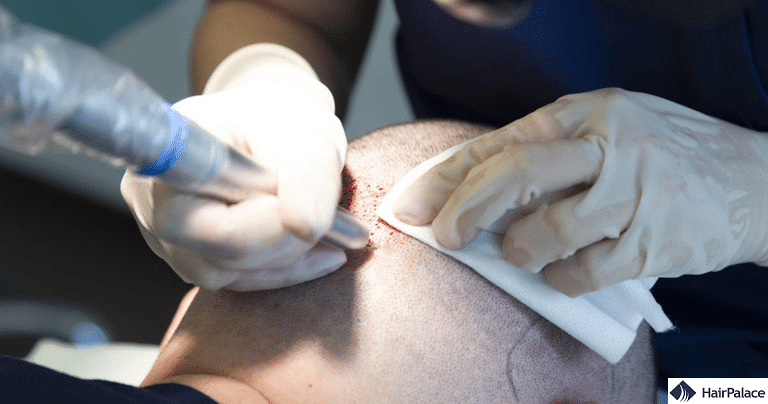Beard Transplant: Procedure, Cost & Results in 2025
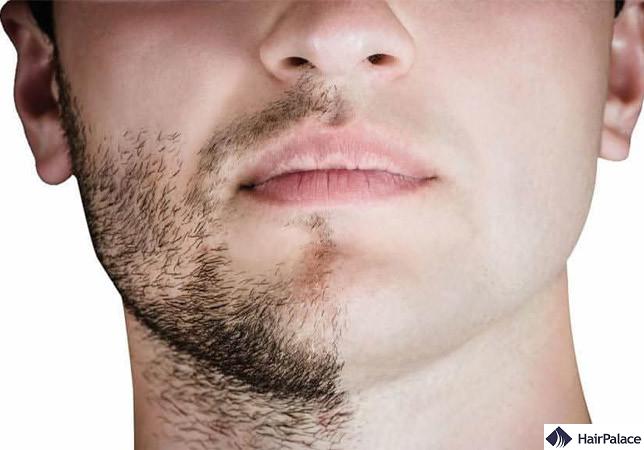
Beard transplants are fast becoming one of the most popular cosmetic treatments worldwide. And it’s easy to see why.
This procedure uses techniques like Follicular Unit Extraction (FUE) or Follicular Unit Transplantation (FUT) for natural-looking, seamless results.
Recovery is relatively quick, with full beard growth typically visible within 12-15 months, and the transplanted hair is permanent.
Let’s explore every important detail about the nuances of beard transplantation, including cost, methods, and results.
Beard transplant UK fast facts
| Duration of surgery | 4 to 8 hours |
| Number of follicles | typically 1500 – 4000 |
| Beard transplant cost UK | from £3000 to £10000 |
| Hospital stay | no overnight stay needed |
| Anaesthetic type | local |
| Pain levels | none to minimal |
| Risks | redness, temporary swelling, numbness of the scalp, itching |
| Scarring | not visible |
| Recovery | 3-4 months post-surgery |
| Final result | in 8 to 12 months |
What is a beard transplant?
Simply put, a facial transplant takes hair grafts from a donor area (i.e., the back of the head or lower parts of the chin) and implants them into targeted areas to restore facial hair.
Beard implants are often so successful that only one procedure is required to achieve a great result.
Because you’re using your very own hair, your beard will be natural-looking and will show no signs of surgery.

Moreover, a beard hair transplant allows you to sculpt your beard the way you want.
During your consultation, you will, along with your surgery, decide precisely where to implant hair and sculpt the beard to your liking.
You can match your beard’s shape to fit perfectly with your facial features!
How does a beard transplant work?
Beard implants may seem complex initially, but we’re here to break it. Whether it’s FUT or FUE beard transplants, surgery usually follows the following three points:
- Extraction
Depending on your procedure type, your surgeon will extract individual hair follicles (FUE) or cut a strip of tissue (FUT) from the donor area. - Transplantation
Once your surgeon has extracted the required hair grafts, there will be a short break.
Afterwards, your surgeon will carefully implant hair follicles one by one into the recipient area, being careful to place them strategically to create a full beard. - Recovery process
After your surgery, you can return home. Most patients require a day to recover fully. Some tiny crusts may appear around the new beard hairs, but they should flake off naturally after a few days.
New hair will start to grow, and you can look forward to developing a fuller beard.
Beard hair transplant treatment methods
There are different methods available to perform beard implants. The two most common techniques used are:
Which method is better?
Both methods are effective at treating beard hair loss.
They can transplant up to 5000 grafts in a single procedure, which is more than enough to treat your jaw area. Both are performed under local anaesthetic.
Many patients opt for an FUE beard transplant because it leaves no scars, has a quick recovery, and is less painful.
Ultimately, your surgeon will recommend the most appropriate hair transplant procedure after examining your scalp during your consultation.

Beard transplant cost UK
So what prices can you expect in the UK? The minimum you will pay for a beard hair transplant here is £2,000, though some clinics can charge up to £7,500.
That might sound expensive, especially when considering clinics overseas. But we always recommend you invest in the best.
A reputable clinic with experienced staff will cost you more but guarantees better, more natural-looking results.
The cost of a beard transplant in London may seem high, but in most cases, it is more than worth it.
Some clinics offer a range of payment and financing options, allowing you to access more expensive care. Any packages or financing options will be explained to you during your consultation.
Beard transplant results: before & after
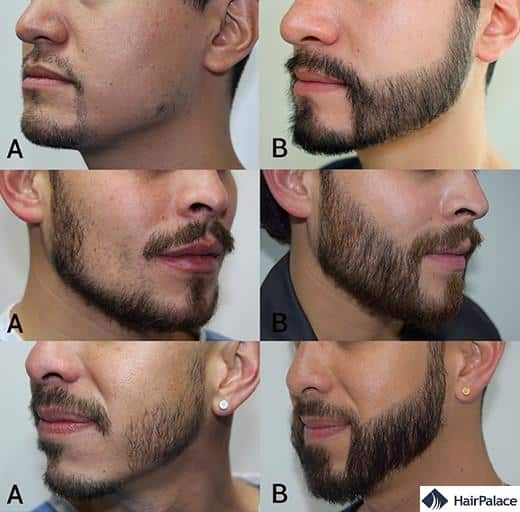
Where does the transplanted hair come from?
The reason beard hair transplants are so successful is that implanted hair comes from your very own head.
But won’t you miss this hair? Not quite. Hair is often taken from spots with the highest hair density, which aren’t affected by male pattern baldness.
These are usually the lower back of the head and the sides.
Depending on the surgeon’s skills, they may also harvest hairs from your neck and jawbone, depending on how many grafts your new beard may require.
Pros and cons of a beard transplant
Like any hair restoration surgery, beard implants have their pros and cons. Let’s take a quick look at them:
Pros
- A permanent solution to patchy facial hair
- Dramatic confidence boost
- Natural looking results
- Quick and painless procedure
Cons
The most common side effects and complications
Design is one of the most commonly arising problems with a beard transplant in Turkey.
Patients are often given the Turkish beard line, which requires a large number of grafts.
It’s not uncommon for clinics to extract as many as 9000 grafts to achieve this look.
While the result is dense, this has drawbacks. The biggest of which, is the increased risk of damage to the donor area.
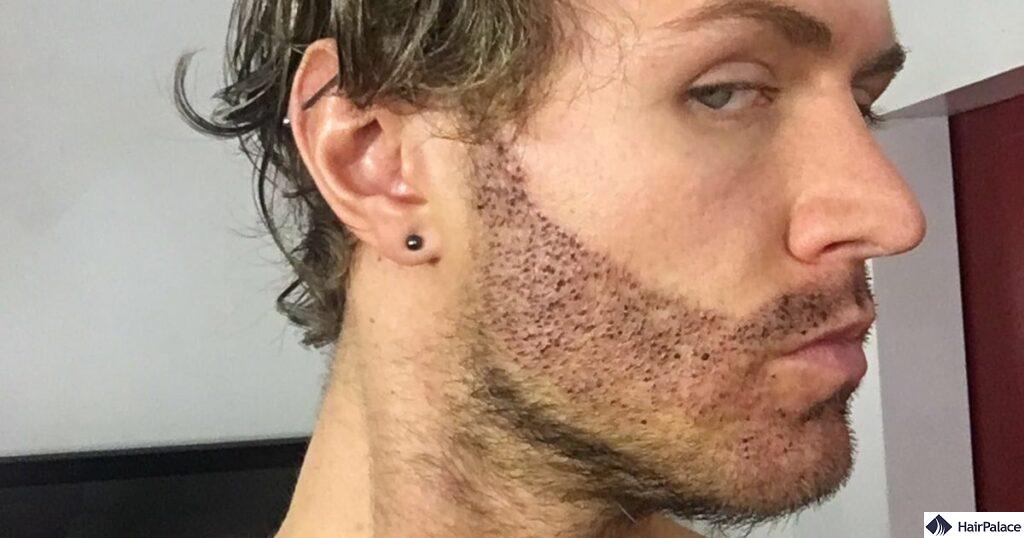
If the transplant fails the patient is left with no way of correcting the hairline due to the lack of healthy hairs.
This can prevent patients from ever having a natural clean-shaven look again, as there are visible scars in the donor area.
Additionally, after more extensive procedures, the implanted area may remain red for up to 4 months.
Many clinics advise their patients to use minoxidil after the transplant. However, this is completely unnecessary and may cause more harm than good.
Patients often report symptoms of folliculitis and acne flair-ups, which can get worse with the application of minoxidil.
While there are numerous Turkish clinics offering beard transplants for cheap, they often cause lifelong trauma to patients.
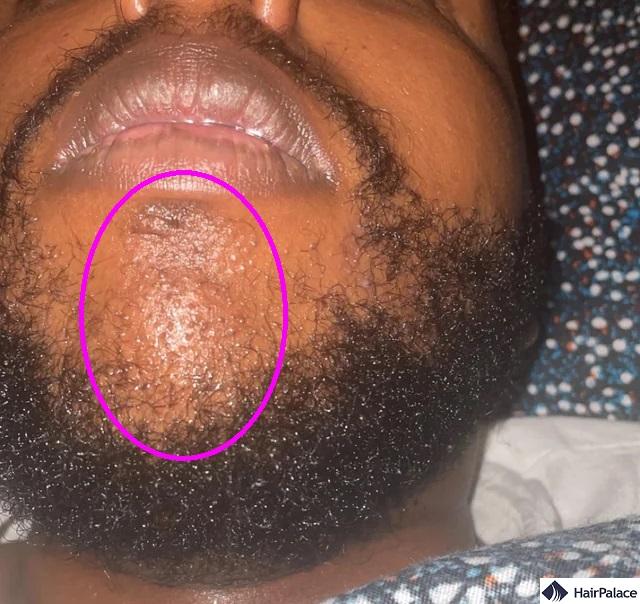
Many of these clinics offer beard transplants with scalp hair, which creates a dense result and adds significant weight to your face.
You may notice a strange feeling of being weighed down by your beard throughout your beard transplant recovery, which can persist long-term.
Lastly, these clinics often employ untrained staff, which leads to complications such as pitting, cobblestones, and permanent skin damage.
Should you get a beard transplant?
Beard implants and other forms of facial hair transplants, such as eyebrow transplants are incredibly popular nowadays.
People often want a beard and moustache transplant as early as their teenage years or early twenties.
However, it’s important to stay patient.
Your beard growth may develop up to your mid-twenties, or even later.
Getting a beard transplant too early can harm you in the long run, as you may use up all of your donor hairs before any hair loss occurs.
We advise all patients to wait until their 30s before considering a procedure.
Many people experience growth spurts later in life, so it’s best to avoid unnecessary procedures and remain patient.
Beard Transplant FAQ
You can expect to pay between £2000 and £7000, but prices may vary based on certain factors.
An ideal candidate should have a good donor hair supply (typically at the back of the scalp), realistic expectations, and be in good general health without conditions that affect healing or hair growth. A stable pattern of hair loss is also important to ensure long-lasting results.
A beard transplant can leave very small scars, especially at the donor site. However, with modern techniques like FUE (Follicular Unit Extraction), these scars are minimal and often barely visible. Proper aftercare helps reduce any noticeable scarring.
Hair for a beard transplant is typically taken from the back or sides of the scalp, where it closely matches beard hair in texture. These donor hairs are transplanted one by one into the beard area. Once transplanted, they grow like natural beard hair and can be shaved or styled normally.
You can shave a beard transplant once the area has fully healed, usually after a few weeks. The transplanted hairs behave like natural beard hair, so shaving won’t damage them. Just wait until your surgeon gives the go-ahead to avoid irritation or infection.
Beard transplants are generally permanent because the transplanted hair follicles are taken from areas resistant to hair loss. Once they take root, they grow just like natural facial hair. Proper care ensures they last a lifetime.
Last medically reviewed on May 6th, 2025
- Epstein J. Facial hair restoration: hair transplantation to eyebrows, beard, sideburns, and eyelashes. Facial Plastic Surgery Clinics.2013;21(3):457-467. https://doi.org/10.1016/j.fsc.2013.05.004
- Bared A.What’s New in Facial Hair Transplantation? Effective Techniques for Beard and Eyebrow Transplantation. Facial Plastic Surgery Clinics.2019;27(3):379-384.https://doi.org/10.1016/j.fsc.2019.04.003
- Gandelman M. Epstein J.S. Reconstruction of the sideburn, moustache, and beard.Facial Plast Surg Clin North Am.2004;12:253-261.https://doi.org/10.1016/j.fsc.2003.12.002
- ISHRS: 2020 Practice Census Resultshttps://ishrs.org/wp-content/uploads/2020/05/Report-2020-ISHRS-Practice-Census-05-22-20.pdf
- ISHRS: Beard And Mustache Transplanthttps://ishrs.org/2021/03/29/beard-mustache-transplant/
- Dua A, Dua K. Follicular unit extraction hair transplant. J Cutan Aesthet Surg. 2010;3(2):76-81.https://doi.org/10.4103/0974-2077.69015

